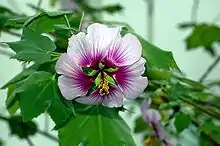Lavatera
Lavatera[1] is a genus of about 25 species of flowering plants in the mallow family Malvaceae, native to Macaronesia, North Africa, Europe, central and southwestern Asia, Ethiopia, North America (California and Mexico) and Australia, with a centre of distribution in the Mediterranean region. A number of species are naturalized in North America and elsewhere.
| Lavatera | |
|---|---|
 | |
| Lavatera maritima | |
| Scientific classification | |
| Kingdom: | Plantae |
| Clade: | Tracheophytes |
| Clade: | Angiosperms |
| Clade: | Eudicots |
| Clade: | Rosids |
| Order: | Malvales |
| Family: | Malvaceae |
| Subfamily: | Malvoideae |
| Tribe: | Malveae |
| Genus: | Lavatera L. |
| Species | |
|
About 25, see text | |
| Synonyms | |
| |
All species previously placed in Lavatera have now been transferred to the related genus Malva. Lavatera species are known as tree mallows, or rather ambiguously as rose mallows, royal mallows or annual mallows.
The genus includes annual, biennial and perennial herbaceous plants and soft-wooded shrubs, growing from 1–3 m tall. The leaves are spirally arranged, and palmately lobed. The flowers are conspicuous, 4–12 cm diameter, with five white, pink or red petals; they are produced in terminal clusters.
Lavatera species are used as food plants by the larvae of some Lepidoptera species including Bucculatrix lavaterella, which feeds exclusively on these plants. Flowers and seeds of several species are also used as food by humans.
Name etymology
This genus is named after the Lavater brothers, 17th century Swiss physicians and naturalists.[2]
Selected species
- Lavatera abyssinica
- Lavatera assurgentiflora – California tree-mallow
- Lavatera acerifolia – Malva de Risco
- Lavatera bryoniifolia
- Lavatera cachmeriana
- Lavatera cretica – smaller tree-mallow
- Lavatera flava
- Lavatera insularis
- Lavatera lindsayi
- Lavatera maritima
- Lavatera maroccana
- Lavatera mauritanica
- Lavatera microphylla
- Lavatera oblongifolia
- Lavatera olbia
- Lavatera phoenicea
- Lavatera plebeia
- Lavatera punctata
- Lavatera stenopetala
- Lavatera thuringiaca – garden tree-mallow
- Lavatera triloba
- Lavatera trimestris – annual tree-mallow
- Lavatera valdesii
- Lavatera vidali
- Lavatera venosa
References
- Synonymy of Lavatera at Malvaceae Info
- Jepson eFlora LAVATERA Website accessed on 17 February 2014
External links
- Malvaceae Info: The Lavatera pages
- Germplasm Resources Information Network: Lavatera
- Flora Europaea: Lavatera
- Virginia Tech page showing distribution in North America
- Jepson Manual showing detailed California distribution
| Wikimedia Commons has media related to Lavatera. |
